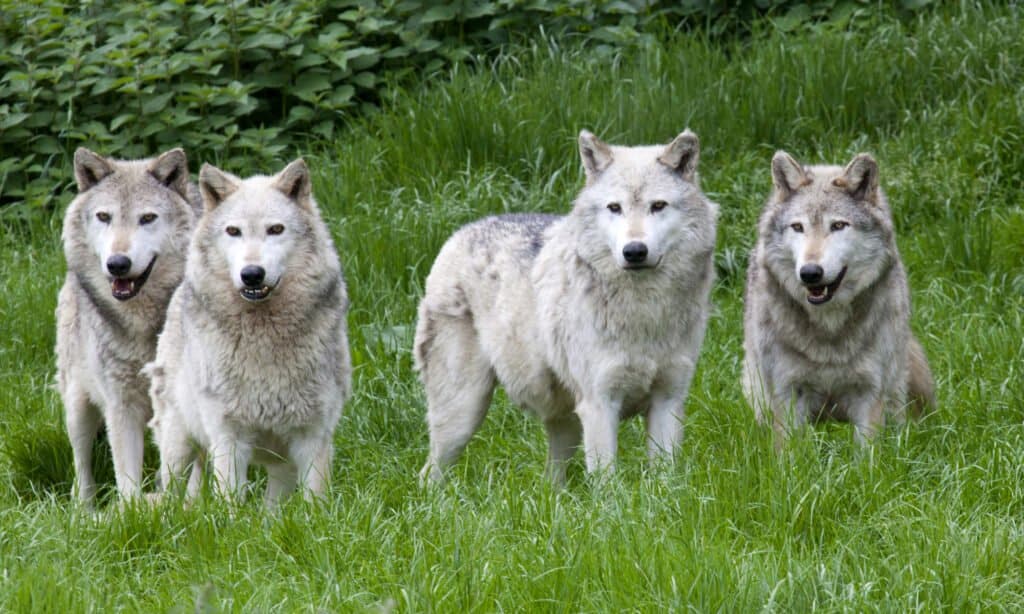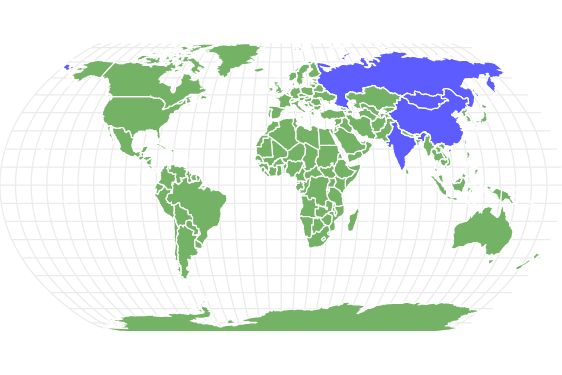Eurasian Wolf
.jumbotron {
background-image: url(“https://a-z-animals.com/media/2022/03/Eurasian-wolf-1-400×300.jpg”);
}
}
@media only screen and (min-width: 641px) and (max-width: 920px) {
.jumbotron {
background-image: url(“https://a-z-animals.com/media/2022/03/Eurasian-wolf-1-470×370.jpg”);
}
}
@media only screen and (min-width: 921px) {
.jumbotron {
background-image: url(“https://a-z-animals.com/media/2022/03/Eurasian-wolf-1.jpg”);
}
}
Eurasian Wolf
Canis lupus lupus
Coloring depends on location.
Eurasian Wolf Facts
- Prey
- Moose, deer, wild boar, reindeer, argali, mouflon, wisent, saiga, ibex, chamois, wild goats, etc.
- Name Of Young
- pups
- Group Behavior
-
- Pack
- Fun Fact
- Coloring depends on location.
- Estimated Population Size
- 150,000
- Biggest Threat
- Deforestation, humans.
- Most Distinctive Feature
- Tawny coat
- Other Name(s)
- Common wolf, European wolf, Carpathian wolf, steppes wolf, Tibetan wolf, Chinese wolf
- Gestation Period
- 7 weeks
- Litter Size
- 6 pups
- Habitat
- Tundra, plains, scrublands, mountains.
- Predators
- none
- Diet
- Carnivore
- Type
- mammal
- Common Name
- Eurasian Wolf
- Number Of Species
- 1
- Location
- Western Europe, Scandinavia, Russia, China, Mongolia, Himalayan mountains.
- Group
- Pack
Eurasian Wolf Physical Characteristics
- Color
-
- Grey
- Red
- Black
- White
- Cream
- Tawny
- Skin Type
- Fur
- Lifespan
- 6-8 years, though some live up to 17 years.
- Weight
- 86 to 174 lbs.
- Height
- 31 to 33 inches, at the shoulder
- Length
- 41 to 63 inches
- Age of Sexual Maturity
- 2 years
- Age of Weaning
- 8 weeks
This post may contain affiliate links to our partners like Chewy, Amazon, and others. Purchasing through these helps us further the A-Z Animals mission to educate about the world’s species..

Spiders that fly! Fish that walk! And 1000+ more incredible animals. Discover them all for FREE
.photo-gallery {
–margin: 0px auto 0px;
–padding: 0px 0px 0px 0px;
}
.gallery-link {
background-image: url(“https://a-z-animals.com/media/2022/03/eurasian-wolf-2-1024×614.jpg”);
background-repeat: no-repeat;
background-size: cover;
background-position: center;
height: 500px;
justify-content: center;
text-align: center;
align-items: center;
display: flex;
border: 2px solid #000;
}
.gallery-link img {
height: 50%;
}
@media only screen and (max-width: 768px) {
.gallery-link {
height: 300px !important;
}
}
View all of the Eurasian Wolf images!
TheEurasian Wolf is also known as the Russian forest wolf or common wolf.
This wolf is the largest subspecies of gray wolf in the world. It can live to be up to 17 years old, though they typically live to be 6-8 years old in most regions. With a litter of about 6 pups each, only alphas in a pack will mate, even though the packs are no more than 7 wolves at the most. This species has been hunted to extinction in many countries, but it still thrives in Russia, China, and nearby countries.
4 Eurasian Wolf Facts
- Due to preying on livestock, the Eurasian wolve has been hunted to extinction in many areas of Europe, including Ireland and England.
- The highest population of Eurasian wolves can be found in Russia.
- Though they aren’t exactly friendly, Eurasian wolves aren’t quite as shy around humans as the traditional grey wolf is.
- Only the alpha female and male wolves in a pack will reproduce. The rest are physically harassed to prevent it.
Eurasian Wolf Scientific Name
The Eurasian wolf has many names, including the common wolf, European wolf, Carpathian wolf, Steppes wolf, Tibetan wolf, and Chinese wolf. It is a subspecies of the grey wolf with the scientific name Canis lupus lupus. It is part of the Canidae family and the Mammalia class.
The word “Canis” is Latin, meaning “of the dog.” “Lupus,” on the other hand, literally means “wolf.”
Eurasian Wolf Appearance & Behavior
The Eurasian wolf, a subspecies of the grey wolf, has many adaptations in its physical appearance to survive, especially considering how close they’ve come to extinction many times. With a tawny color, these wolves can easily conceal themselves against the cold winters in Russia, blending against the color of the mountains. The fur can also be black, Typically, they have a thick chest that is white in color, though the white fur almost reaches their eyes. The coarse and short fur is another one of its adaptations to keep them warm in the northern regions, though it is much denser and shorter than wolves in North America.
The average size of this wolf also changes from one region to another. In Europe, they typically weigh around 86 lbs., while there are records of wolves weighing 152 to 174 lbs. in other areas.
Though the Eurasian wolf exists in much smaller packs than North American wolves, they are incredibly social and live in groups of about 7 wolves. Only the alpha females and males mate, and the species primarily keeps to itself. They also hunt solitarily.

Alan Jeffery/Shutterstock.com
Eurasian Wolf Habitat
Though the distribution of the Eurasian wolf has evolved through time and extinction, the typical habitat of the Eurasian wolf ranges from Western Europe, Scandinavia, Russia, China, Mongolia, and the Himalayan mountains. It roamed through England, Ireland, and nearby countries at one point, but they were hunted to extinction in the 17th century and later as locals were encouraged to minimize their population. With a much smaller range of distribution, the largest congregation of these wolves exists in Russia where the numbers are thought to be at least 30,000.
Due to their adaptations, the preferred environment for these wolves is in areas with mountains, plains, and woodlands. They aren’t shy around humans, but they will keep their distance if you happen to be nearby.
Eurasian Wolf Predators & Threats
The typical diet of the Eurasian wolf is carnivorous, so they need a steady supply of prey to keep themselves nourished and healthy. They can pursue prey at speeds of up to 37 mph, and they have powerful jaws with large teeth to tear into their prey. With a sharp sense of smell, impressive eyesight, and incredible hearing, hunting is easy, and they have no known predators right now.
What eats Eurasian wolves?
The wolf is an apex predator. There are no predators that hunt them, though their population drastically dropped through the last few centuries as humans hunted them to reduce their numbers.
What do Eurasian wolves eat?
The primary prey of Eurasian wolves involves unregulated wild game, like wild boar, roe deer, moose, and related species. Some species that these wolves will also hunt include reindeer, fallow deer, musk deer, ibex, chamois, wild goats, etc.
Eurasian Wolf Reproduction, Babies, and Lifespan
The typical mating of the Eurasian wolf happens during the winter and early spring. Though they don’t mate until they are older, the Eurasian wolf is sexually mature by the time they are 2 years old. Only one male and one female mate within the pack. All of the other adults in the group are physically intimidated by these two alphas, preventing them from mating at all. With an average of 6 babies (or pups) in a litter, the babies are born after about 7 weeks of gestation.
The pups nurse their mother’s milk for the first 8 weeks of their life, staying within the pack. They live in a den where they are cared for by their mother. The father’s role is to bring food back to the den, which he either brings as whole food or he regurgitates it for the pups to eat. Other members of the pack also contribute to their food supply as they grow.
The typical lifespan of the Eurasian wolf is between 6 and 8 years old. However, in some regions, they can live to be 17 years old in some regions.
Eurasian Wolf Population
The population of Eurasian wolves has changed significantly through the last few centuries. Their role as a major predator made them a threat to the livelihood of anyone holding livestock, leading many people into the organized efforts to exterminate them. These efforts happened over the course of hundreds of years, and it was even enforced at one time through England, Ireland, and other countries in Europe. Even in Sweden, a bounty on wolves started in 1647 because wolves started eating their livestock as well.
Though many countries and regions managed to exterminate the wolf entirely, it preserved a section of the region, with a range that starts at Eastern Europe against the Asian border. Though they once were in the low triple digits in some areas, they now have an estimated worldwide population of about 150,000. Recovering the population from previous efforts started in the middle of the 20th century, and the IUCN now sees the population steadily increasing and is of Least Concern.
View all 68 animals that start with E
Eurasian Wolf FAQs (Frequently Asked Questions)
Are Eurasian wolves carnivores, herbivores, or omnivores?
These wolves are major predators in their natural environment, consuming a carnivorous diet as they hunt in packs.
Is the Eurasian wolf extinct?
At one time, the Eurasian wolf was nearly extinct, and it still doesn’t reside in many European countries. After repopulation efforts in the 20th century, the species is considered to be of Least Concern to the IUCN. It is most rare to see a black Eurasian wolf.
Are Eurasian wolves friendly?
For the most part, Eurasian wolves tend to keep their distance from humans. However, unlike North American wolves that always stay away, this species has no difficulty living near humans, as long as it is from afar.
Why did the Eurasian wolf go extinct?
During the 18th century, this predator nearly went extinct as locals hunted it. As the wolves hunted the locals’ livestock, the locals fought back by killing them off. They still managed to survive in Italy, Poland, and Bulgaria. Hunting these wolves wasn’t outlawed until the 1990s in Poland, which was a major catalyst for the recovery of the species. Some wolves have been seen as far away as the Netherlands, Denmark, France, and Germany.
Where do Eurasian wolves live?
Though the extinction of the Eurasian wolves pulled it out of many countries, it primarily lives in the mountains, scrublands, taiga, plains, and tundra of Europe and Asia.
Sources
- , Available here: https://en.wikipedia.org/wiki/Eurasian_wolf
- , Available here: https://animalcorner.org/animals/eurasian-wolf/
- , Available here: https://www.rewildingbritain.org.uk/explore-rewilding/reintroductions-key-species/rewilding-superstars/eurasian-wolf
- , Available here: https://kidadl.com/animal-facts/eurasian-wolf-facts
- (1970) https://www.activewild.com/eurasian-wolf-facts-for-kids/ Jump to top
















